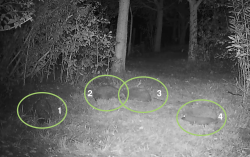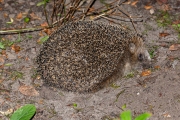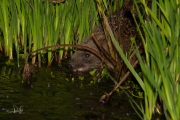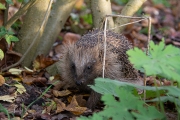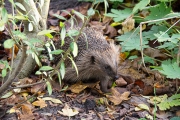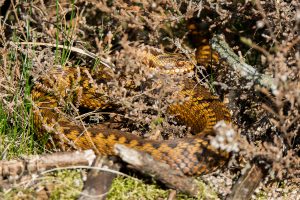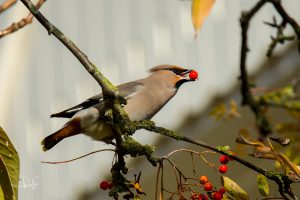In the last weekend of September the annual hedgehog count took place in the Netherlands. This year it was organised for the fourteenth time. Nearly 3400 people all over the country counted the hedgehogs (Erinaceus europaeus) in their garden or local patch and passed their results on to the Zoogdiervereniging (Dutch Mammal Conservation Society). About 9400 animals were counted In contrast to the garden bird count or butterfly count, it is not easy to count the hedgehogs. Since the hedgehog is an animal that only shows itself at dusk and night, you have to look for these animals in the evening. An advantage over the other two counts is that you only have to count one species and that there are generally not that many. Instead of waiting for the evening to count them, you can record them with a wildlife camera like I did. This time I had three hedgehogs on screen. But once I’ve also counted four, as you can see in the photo on the left. Although the hedgehog is one of the most commonly recorded wild mammals in the Netherlands and Belgium, many have never seen a hedgehog in real life. Have you? Nevertheless, there is a good chance that you will encounter one when you take a walk through the garden or park on a beautiful summer evening after sunset.
Eight thousand spines
I don’t have to explain what a hedgehog looks like, because I think everyone knows. The back and top of the head are covered with sturdy spines which are about two to three centimetres long. I haven’t counted them all, but an adult hedgehog seems to have about eight thousand of those prickly spines. One of these spines lasts for about one to one and a half years. After that they fall out and a new spine grows. On the belly and other parts where no spines grow, the hedgehog has rather stiff hairs. Adults are about twenty to thirty centimetres long with a tail of about two to five centimetres dangling behind it. They weigh up to twelve hundred grams, which is about the maximum weight of an adult male. The females are generally slightly smaller and lighter. When a hedgehog literally smells trouble, it usually don’t run away, but stay still where it is. The animal draws in its shoulder and holds its snout down. This causes the spines on its head to stand up. If the hedgehog still feels threatened, it quickly rolls up into a kind of ball. It can do that because it has a very strong sphincter that runs over its back. When rolled up, the head, legs and tail are turned inwards and a very small opening is still visible at the bottom. The rest of the ball is made up of those eight thousand spikes, which cover the entire surface. When the danger has passed, the hedgehog unrolls again within three seconds and rushes to its hiding place.
Vijanden
Despite this effective defence strategy, a hedgehog does have some natural enemies that know how to handle that spiky ball. It is known that the badger (Meles meles) and polecat (Mustela putorius) sometimes eat a hedgehog. British wildlife writer Maurice Burton (1898 – 1992) even calls the polecat in his 1969 book The Hedgehog the most deadly enemy of the hedgehog. But also the pine marten (Martes martes), fox (Vulpes vulpes) and birds such as tawny owl (Strix aluco), goshawk (Accipiter gentilis) and eagle owl (Bubo bubo) occasionally have a hedgehog on the menu. However, the hedgehog’s greatest enemy is us humans. Unfortunately, too many people only know the hedgehog as a dead specimen on or next to the road. Not the nicest view. They are hit by a car while crossing a road at night on their forays. It doesn’t help that they roll up to avert the danger of the approaching car. The hedgehog is one of the most common mammalian victims of traffic in the Netherlands, especially the males. During the mating season (which covers a large part of the spring and autumn) they travel great distances in their search for a female. They do not allow themselves to be stopped by a road. Figures from the beginning of this century indicate that an estimated 113,000 to 340,000 hedgehogs are killed in traffic annually in the Netherlands. No less than 70% of the males die this way, an incredibly high number.
Danger is always lurking
But it is not only because of traffic that humans pose a danger to hedgehogs. We as humans know how to make life miserable for the hedgehog in all sorts of other ways. Hedgehogs sleep about eighteen hours a day, often in heaps of leaves and branches, for example on roadsides. When mowing the verges, where many animals (insects, caterpillars, spiders) are lost anyway, this can be disastrous for the hedgehog. What about the so-called leaf litter collection points that are placed in public places by a lot of municipalities in the autumn, because our gardens have to look spic and span? A perfect place for the hedgehog to sleep until the leaves are picked up with potentially deadly consequences. Or heaps of pruning waste, which are ready to be set alight because of a ‘traditions’ such as bonfires. It is rare for these heaps to be checked for hedgehogs before they are set on fire. Ponds, swimming pools and cattle grids also pose a danger to hedgehogs. They can swim well, but they cannot climb a steep edge. Therefore, make sure that a hedgehog cannot fall in or that there is an opportunity to climb out. For example, a slanted plank in the pond, preferably covered with some gauze so that it is sufficiently non-slip. Incidentally, in recent years another enemy has emerged, namely the mowing robot. Many people have their lawn looking neatly mown day and night (why?). Young, small hedgehogs in particular can end up under this lawnmower with fatal consequences. So if you have such a device, make sure it is switched off at night.
Sniff, squeak, grunt and whistle
If a hedgehog does not end up as prey or traffic victim, it can reach an age of ten years. But usually it won’t get older than about five years. Hedgehogs are not monogamous, they are always alone and form no fixed pair bonds. They do have a fixed ‘territory’, which can be very large, up to more than forty hectares for a male. This should not be seen as a territory to be defended. It is possible that several hedgehogs cohabit the same area or have overlapping territories. Hedgehogs travel considerable distances in that territory at night in search of food or a mate. The mating does not happen without a hitch, by the way, the female does not give in easily. All the time the male tries to court her, it is accompanied by many and noisy sniffs, beeps, grunts and whistles from both sexes. After mating, a gestation period of approximately five weeks follows. At the end of this period, the female makes a nest of grass and leaves. Well hidden among dense undergrowth or a pile of branches. The male has long since disappeared. After mating, he leaves the care of their offspring completely to the female. On average, five young are born per litter but litters of up to ten young sometimes occur. The young hedgehogs, bald and pink in colour, are ‘blind’ after birth. Their eyes – as well as the ears – are covered with skin. These will open after two weeks. When the young are born, they do not have spines yet, they emerge a few hours after birth. These spines are white. A few days later the first light brown to cream coloured spines appear. They only get the fur on the belly and head after a week or two.
Out and about
After being suckled in the nest by the mother for about three weeks, the young hedgehogs leave it for the first time. It looks like a kind of polonaise, mother in front and the young animals head to butt after. There, outside the nest, they eat solid food for the first time. After returning to the nest they are nursed again, but slowly the mother lets the young get used to the ‘adult’ food. This process of habituation is called weaning. About two months after the birth it is time to go out into the wide world and the mother rejects the youngsters. They then have to find their own territory and gather food themselves. The young hedgehogs are certainly not the size of an adult specimen, they weigh about two hundred and fifty grams. The young still have to eat a lot to reach the adult weight of about eight hundred to twelve hundred grams. Incidentally, hedgehogs are already sexually mature in their first year of life, after ten months they can reproduce. In most cases, the females will not give birth to their first litter until their second year of life.
Opportunistic feeder
The hedgehog is anything but picky when it comes to food. Its main diet consists of insects and worms. Sniffing with its snout in the litter and fallen leaves, it searches for prey. And it also uses its keen hearing to hear prey crawling into the ground. It can eat more than 80 worms and beetles in a few hours. In fact, fifty grams of food a night is enough but if the hedgehog can get a little more, it won’t let it pass by. Small slugs are also on its menu, which it eats in one go. It also ventures to snails, especially the little ones. The sturdy shells of the adult snails are too hard to crack. If there are too few worms and beetles available, mushrooms, berries, fruits (apples) and carrion are also on the menu. The latter can be anything, but especially small vertebrates such as frogs, toads, but also small mice and moles. In short, the hedgehog is not a picky eater. You can also feed hedgehogs, but that is usually not necessary. Hedgehogs know how to forage for themselves. Here and there dry cat food is mentioned to give to hedgehogs. But not all of the cat food is suitable. There seems to be cat food with insects, under the guise of vegetarian or hypoallergenic. However, that food can be disastrous for the hedgehogs. It can affect their organs and if they eat it too much and too often, it can also lead to death. If you want to feed the hedgehogs with cat food, pay close attention to the ingredients or give special formulated hedgehog food. Some people also put down a saucer of milk for the hedgehogs. That is not wise, because this will cause diarrhea. After all, cow’s milk is intended for calves and not for hedgehogs.
Hibernation
Around October, the hedgehog starts preparing to go into hibernation. The hedgehog cannot withstand frost, its spine-covered body can protect it against a lot, but not against the cold. And in addition, the food supply in winter is very limited. The winter nest is very simple and consists of a lot of leaves, grass, moss and some plant stems or thin twigs. The hump is constructed in a sheltered spot, such as near a woodpile, a compost heap or against a fence. Sometimes a nest is made in a shed or under a canopy. Once the bump is large enough, a cavity is made in it and a passageway is made to enter. Due to the insulating effect of the layer of leaves and moss, it remains about 1 to 5 °C in the cave when it is -8 °C outside. As soon as the temperature drops below 10 °C, the hedgehog decides it’s time to go into hibernation. It withdraws into the nest, curls up nicely and closes its eyes. Hedgehogs are very solitary and they also hibernate on their own. The hibernation lasts until about March or April, that is how long the animal can go without food. During that period, the body temperature drops from a normal 36 °C to 10 °C, their heart rate goes from 190 to 20 beats per minute. And they only breathe once every two to three minutes. All to waste as little energy as possible. Despite these physical adaptations and the warm nest, the hedgehogs are exhausted when they wake up from hibernation. They are skinny, hungry and have lost as much as thirty to fifty percent of their body weight in severe winters and weigh barely a pound. They are diligently looking for food, so if there is a moment to feed hedgehogs, it is.
Help the hedgehog!
Although the hedgehog is an opportunist in terms of feeding habits and maintains a large territory with many opportunities for shelter and foraging, the hedgehog population is in poor health. In the Netherlands, only thirty percent of the numbers from the 1990s remain (see the graph opposite). A reduction of seventy percent in thirty years! In other countries it is not much better. So help the hedgehog, because just like any other animal, it is also part of our biodiversity!
What can you do to help hedgehogs?
- A neatly raked and trimmed garden is disastrous for biodiversity. Hedgehogs, as well as many other animals, love lush gardens. They find hiding places there, but there is also plenty of food available. And make sure you have a nice messy corner that is not in sight. You will be amazed at what that gives to life!
- Gardens are often separated with rock-solid fences that are impossible for a hedgehog to get through. Meet up with your neighbours and make a small hole in that fence. A height and width of about fourteen centimetres is sufficient. This way the hedgehog can move from one garden to another. And if you do that with the entire street, a real “hedgehog highway” is created :-).
- Put a hedgehog box in your garden. (See the two examples from my own garden in the photos below. One is hidden under the logs and soil, but is made of an inverted mortar tub with a wooden plate at the bottom. The access tunnel is under the logs. The other is made of waste wood from the terrace and has an ‘indoor’ tunnel.) There are several examples on the internet for building these, but you can also buy them ready-made. Pay attention to the quality, because a lot of junk is sold under the motto “Good for nature”. After all, nature has become big business. There are for instance thatched hedgehog houses for sale that are of inferior quality.
- Do you have a pond? Then make sure that there is a sloping bank or a gangway so that the hedgehog can get out if it unexpectedly ends up in the water.
- Might be a no-brainer, but don’t use poison in your garden. Hedgehogs eat snails and if they are exterminated with snail venom, the hedgehog also ingests it with often fatal consequences.
- Watch out for crossing hedgehogs in traffic! Of course, also pay attention to other traffic and your own safety. But every hedgehog that can be saved like this is one!
- And finally: supplementary feeding is allowed, but with good food.
With a little effort you can help these animals and you can also enjoy them in your garden!
Bronnen (in Dutch):
- Zoogdiervereniging
- Egelwerkgroep
- Egelbescherming
- Wikipedia
- Wildlife Online
- Tuintelling
- Nature Today
- Vroege vogels
This item was originally published in Dutch on October 15th 2022.



